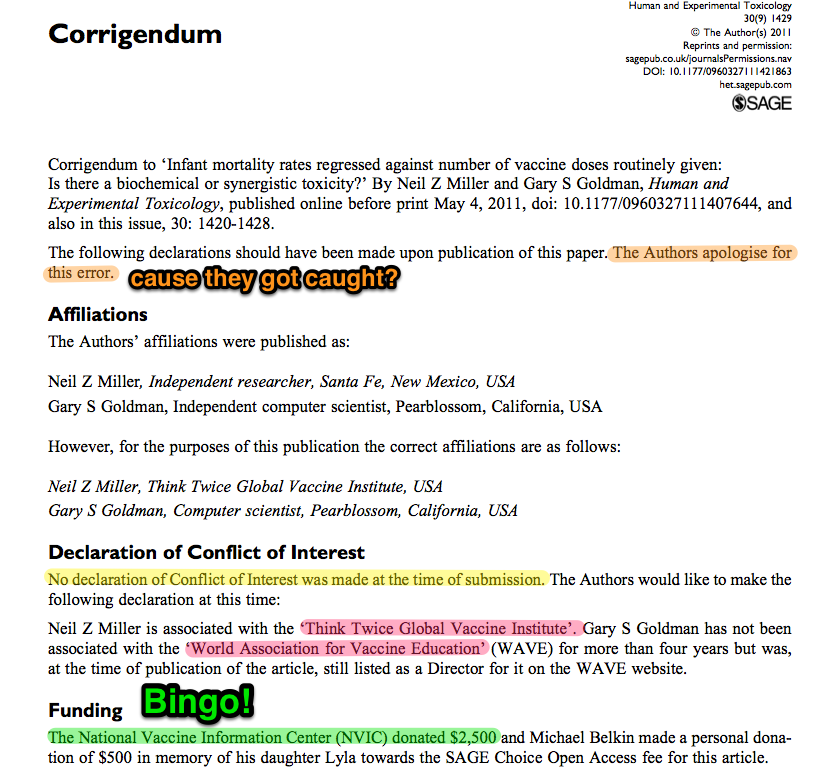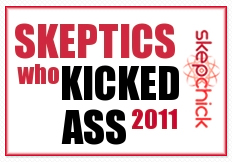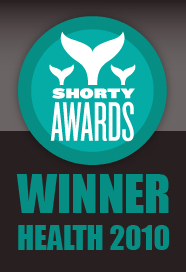Imagine if you heard about an explosive new scientific article that had been published in the peer review literature and claimed that the childhood vaccination schedule was actually dangerous.
So dangerous in fact, that there appeared to be a correlation between the number of vaccines kids received and a higher incidence of infant mortality. What a terrifying concept.
After you have scrambled to get the full text of the article, you quickly scan it to try to determine if it’s of high quality. The first place to look would be the journal itself, is it high impact? Then the authors themselves, are they well known in this field? Is their work of a high standard? Is the experimental design sound? Do they have any obvious conflicts of interest?
Huh. Conflicts of interest (COIs). A very important factor to consider.
Recently I blogged about COIs and why it is important to declare them, particularly in academic publishing. Personally, I think this should extend to any relevant forum and include everyone who is involved in the discussion (within reason and where appropriate).
On The Conversation for example, authors are required to declare conflicts of interest and on many threads, commenters also get involved, often declaring where their biases lie. This is important so we can assess the veracity of an contributor’s claims and make a judgement about how trustworthy their information or opinion is.
In science and medicine, COIs are particularly important, and indeed many academic journals insist on this information before a paper is published.
Remember “Dr” Andrew Wakefield who caused one of the largest public health scares in the history of modern medicine by claiming the MMR vaccine might be linked to autism? Well he “forgot” to tell The Lancet that he was being paid by lawyers representing autistic children to build a case against the manufacturers of MMR. He also “forgot” to tell the journal he had a patent for his very own single measles vaccines and hence by advising parents to “split the triple jab up” into single components, stood to directly financially benefit when people sort a single alternative. He also “forgot” to mention that he had developed a diagnostic kit for the condition he claimed to have discovered – autistic enterocolitis – from which he also stood to make a tidy profit.
It’s old news now, but when the paper was finally retracted in 2010, (12 years after publication) the editor of The Lancet, Richard Horton, lamented,
“In my view, if we had known the conflict of interest Dr Wakefield had in this work I think that would have strongly affected the peer reviewers about the credibility of this work and in my judgement it would have been rejected.”
I’ve previously written about Prof Brian Martin not being completely transparent about where his interests lie, but then not all journals ask for a declaration of a COI. See this recent Martin article in Health Promotion International for an example.
But the article I alluded to above, which was sent to me by Michael, is a doozy. At first glance, it’s a vaguely anti-vax article attempting to make a link between the number of vaccines on the US schedule and the infant mortality rate (IMR). The authors thesis is that despite the United States spending more per capita on health care than any other country, 33 other nations have better IMRs. And why? Well maybe because the US childhood immunization schedule specifies 26 vaccine doses for infants aged less than 1 year — the most in the world!111elevenbty
Now normally when I come across studies like this, I’ll go straight to the COI statement to see if the authors have any vested interests. Apparently not, as the COI pasted below explains,
Funding
This research received no specific grant from any funding agency in the public, commercial, or not-for-profit sectors.
Then there’s this:
Neil Z Miller, Independent researcher, Santa Fe, New Mexico, USA
Gary S Goldman, Independent computer scientist, Pearblossom, California, USA
“Independent” researchers? Well that’s suspicious right there. (I’m kinda surprised this got past the reviewers but there you go).
Maybe this was what tipped someone off to the true identity of these “Independent” researchers, because when you view the article now, it’s a very different story. Indeed a correction has been published and I’ve highlighted the relevant bits below.
Oh right, so Gary S Goldman used to be just the Director of World Association for Vaccine Education (WAVE). I’d not actually heard of them before, but with the url, novaccine.com, I guess you can figure out what their agenda is. As for the Think Twice Global Vaccine Institute, anyone want to have a guess what they think about vaccines? Have a go in the comments!
And notice who paid the open access fee? None other than the NVIC, the large US anti-vax organisation headed up by Barbara Loe Fisher.
If I were the editor of this journal, I would have been less lenient on the authors for the omission of such important affiliations. I would have retracted the paper, because this is simply dishonest. What’s that phrase? Lying by omission? Yeah that.
So what do you think about this article now? Now that you know the NVIC paid for the open access and that both the authors have anti-vax connections, does this change your view of these findings? Well, it certainly does mine.
This is why declarations of COI are so important. And why I question the motives of those people who don’t declare them and claim they don’t need to. Because, in my mind, it implies they’ve got something to hide. And in this case, these authors quite clearly did.
PS: for a thorough critical analysis of the article see David Gorski’s takedown here.
Browse Timeline
- « Tipping the scales on false balance
- » Proposed health care legislation to crack-down on dodgy claims






